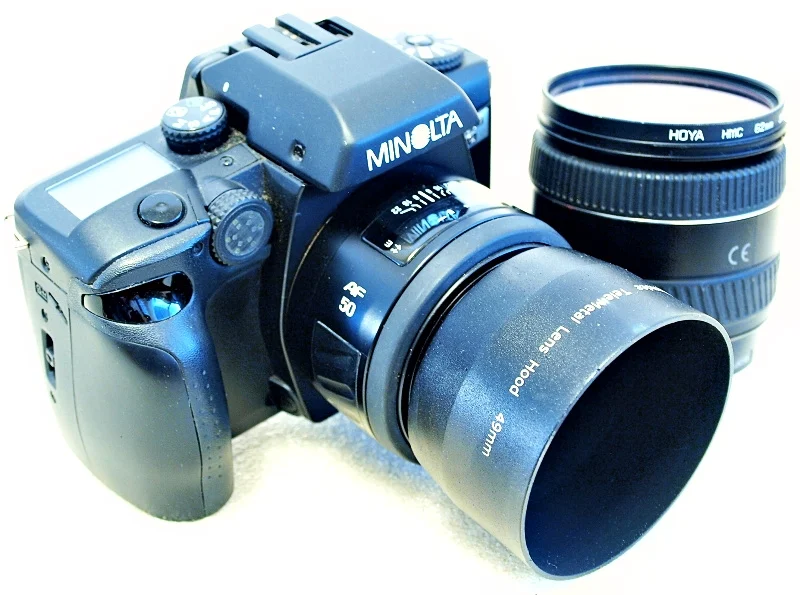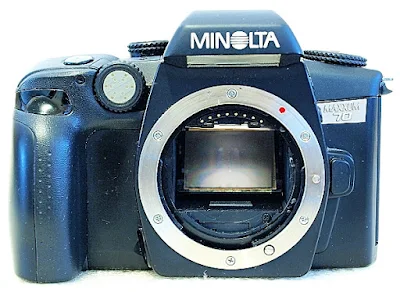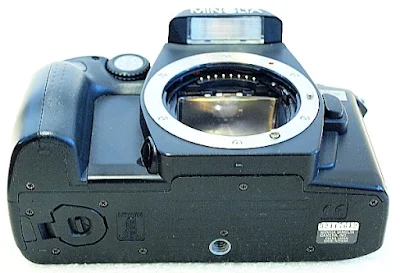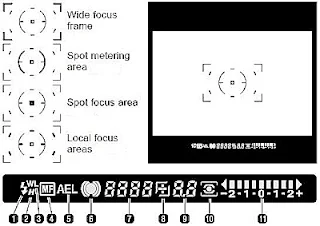The Vintage Enthusiast: An autofocus 35mm SLR film camera with advanced features from Minolta.
A gem of a camera, the Minolta Maxxum 70 (Alpha 70, Dynax 60), produced in 1964, is one of the last film cameras produced by Minolta. The super-compact Maxxum 70 (as Dynax 60, the camera won the EISA 'European SLR Camera of the Year 2004-2005) is an all-round super performer with an advanced nine-point AF sensor, multi-dimensional predictive focus control, direct manual focus, as well as features like high-speed operation, ADI flash metering, and 14 custom functions.
The Maxxum 70 is fitted with an electronically controlled vertical-travel focal-plane shutter with a speed range from 30 seconds to 1/2000 second, with a flash sync speed of 1/90 second. Metering is TTL based on a 14-segment honeycomb silicon photocell with a range of 1 to 20 EV (ISO 100, F1.4) and a spot metering range of 4 to 20 EV. The camera accepts DX-encoded films with ISO speeds from 25 to 5000, while non-DX films can be set from ISO 6 to 6400 in 1/3 aperture stops.
Exposure modes are PASM along with PA and PS modes. The program exposure mode contains 5 separate modes including portrait, landscape, close-up, sport, and night portrait. Film transport is motorized with a selection of a single or continuous drive speed of up to 3 fps. Rewinding the film is automatic at the end of the roll, but a manual rewind is also possible before the end of the roll. The camera is powered by two CR2 batteries.
Minolta Maxxum 70 35mm Film SLR Camera Review/Tutorial
I hope you enjoy this video if you do please like, comment, and subscribe. It really helps me out:-) Also check me out on Ebay @That_Canon_Guy
Alas for the genre of 35mm AF SLR film cameras, the Maxxum 70, alongside the Maxxum 40, was produced in the same year Minolta released their first DSLR, the 7D, and soon afterward, the 5D. The market for film SLRs was coming to its end and this very advanced and highly capable camera was but a brief and brilliant moment in a dying market.
Basic Camera Features
Feature-packed with a clear and easy-to-use and follow operating logic, the Maxxum 70 only dates back to the year 2004, still a young one from the vantage point of view. As seen on auction sites or mail-order listings, most units offered are well preserved, hardly used, and come as a great value for film photo enthusiasts who have a penchant for Minolta or Konica-Minolta A-mount lenses.
Showing little of the sophistication of its electronically controlled functions, the Maxxum 70, as the rest of the camera is as well, has a decidedly simple and plain front.
On the front plane, aside from the lens housing mount which extends up to support the built-in flash, there is only the lens release button to the right of the mount, and on the left, the comfortable finger grip, function control dial located up where the shutter finger rests, and depth of field preview button located on the lower-left corner of the mount.
On the leftmost of the top plane is the main function dial, silkscreened with a circular array of functional selects and a central function button on the axis of the dial.
The SLR roof-mirror box and the built-in flash hump, are slightly off-centered to the left next, while the whole of the right side on the top plane is occupied by the Power switch/shooting mode and mode dial, LCD display panel, and shutter release button.
The back of the camera is fairly spartan as well. Aside from the hinged film back that has a film ID window to it, there is only the rubber-cupped viewfinder eyepiece, with the diopter correction slider behind it, and to the right of the back of the top plane, the AF, Slow Sync/AEL, and AF/MF ball buttons.
On the bottom plane, only the tripod socket and battery chamber cover.
The film box of the Maxxum 70 is a fairly standard autoload type with the film back opening from right to left, and the film canister chamber, shutter window, sprocket gear, and auto take-up spool laid out logically from left to right.
Film Loading and Rewind
Film loading and rewind on the Maxxum 70 are both automated, with the rewind having a manual override for mid-roll rewind.
,p>For loading, the film is placed into the film canister chamber and the film tab end is pulled over to the edge of the take-up spool and tensioned before closing the back. The autoload function will take over and advance the film to Frame 1.The camera will rewind the film automatically at the end of the roll.
Viewfinder Readout
The Maxxum 70 is fitted with a 90% coverage viewfinder screen with etched markings for a wide focus frame, spot metering area, spot, and local focus area.
The spot and local focus area are briefly illuminated to indicate where the focus is locked to when the shutter is released.
The LED display bar located at the bottom of the viewfinder screen displays, when activated, the following indicators:
- 1 - Flash, 2 - High-speed sync, 3 - Wireless / Remote flash, 4 - Manual focus, 5 - Metering mode, 6 - Battery condition, 7 - Remote control, 8 - Film frame, 9 - Film transport, 10 - Cartridge mark, 11 - Direct Manual Focus, 12 - EV scale.
LCD Panel Display
The LCD panel displays relevant information when activated:
-
1 - Subject program, 2 - Exposure compensation, 3 - Aperture, 4 - Manual focus, 5 - Metering mode, 6 - Battery condition, 7 - Remote control, 8 - Frame counter, 9 - Film transport, 10 -Cartridge mark, 11 - Direct Manual Focus, 12 - AF mode, 13 - Wireless / Remote flash, 14 - Red-eye reduction, 15 - Flash mode, 16 - High-speed sync, 17 - Self-timer, 18 - Date imprinting, 19 - Single frame / Continuous advance, 20 - Shutter speed, 21 - Multiple exposures, 22 - Exposure bracketing.
Diopter Correction
One neat feature of the Maxxum 70 is the Diopter Correction slider, adjustable from -2.0 to +1.0 diopter. The sliding adjuster, however, is rather hidden behind the eyepiece cup.
To adjust, slide the eyepiece cup upward, and while looking through the viewfinder, adjust the slider position until the image of the focus frame is sharp.
Metering Modes
Metering modes available on the Maxxum 70 are:
- 14-segment honeycomb-pattern metering - the standard model. When used with non-D series lenses, this mode changes automatically to center-weighted.
- Center-weighted metering, and
- Spot-metering
Program Modes
Program modes on the Maxxum 70 are set by rotating the Power switch/Shooting mode dial to the desired index mark. Options available are:
- Full Auto Program - the camera controls all fundamental shooting modes automatically and resets Flash, Focus area, Autofocus, Drive, Metering, Exposure compensation, Multiple exposures, and Wireless / Remote modes back to default values.
- Program Mode - where the camera controls both shutter speed and lens aperture opening for correct exposure.
- Aperture-Priority
- Shutter-Priority
- Manual Exposure, and
- Bulb Mode
- Subject Programs include;
- Portrait
- Landscapes
- Close-up
- Sports Action
- Night Portrait
Flash Modes
Flash modes available are:- Autoflash - where the built-in flash pops up and fires in low ambient light situations.
- Fill flash - where flash fires with each exposure regardless of lighting conditions.
- No flash - flash will not fire, normally set when flash photography is prohibited.
AE Lock
The AE-Lock button will lock the exposure without activating the AF system.
AF Lock
The AF-Lock button allows the camera to focus on a specific target using the spot-area focus or one of the eight local focus areas.
To activate the local focus areas, press the AF-lock button, and joggle the function control dial for the correct AF location. You can also half-press the shutter button here to lock in the exposure before reframing and releasing the shutter button fully.
AF/MF Switchover
The AM/Mf button will let you override the AF control system and let you focus the lens manually. Push the button once to activate, and gain to return the camera to AF mode.<
Managing the Camera's Functions
The main functionalities of the Maxxum are controlled mainly by (1) rotating and aligning the function item on the function dial to the index mark on the camera body.
Next (2), press the function button in the middle of the dial, and (3) juggle the function control dial on the front of the camera for the right setting.
The function dial incorporates the following:
- CUST - for setting custom functions
- ISO - for setting the custom film ISO speed
- Red-Eye Reduction
- Wireless / Remote flash
- Drive modes
- Metering modes
- AF modes
- Multiple exposures
- Audio signals
- DATE / SEL - for date and time setup and imprinting on date models.
Custom Functions
The Maxxum 70 provides a range of 15 custom functions to select and set for the camera. Setting the custom function is by (1) rotating the function dial to CUST, (2) by joggling the function control dial to the desired custom setting, and (3) by pressing the Function button on the function dial and joggling the function control dial simultaneously for the setting selection.
Custom functions and settings are:
- AF shutter priority - (1) AF Priority (2) Release Priority
- Film Rewind - (1) Automatic (2) Manual
- Film leader at rewind - (1) Wind in (2) Leave out
- DX memory - (1) Off (2) On
- Shutter lock - no film - (1) Unlocked (2) Locked
- Lens focus-hold button - (1) Focus hold (2) Continuous AF (3) Depth-of-Field
- Program shift - (1) Off (2) PA (Aperture shift) (3) PS (Shutter-speed shift)
- AF Button - (1) Spot focus priority (2) AF-area selection
- AEL Button - (1) Hold (2) Toggle
- AF Illuminator - (1) On (2) Off
- Flash metering - (1) ADI (2) TTL
- Focus area illumination - (1) 0,3 sec. focus lock indication (2) 0.6 sec. focus lock indication (3) focus area selection only
- Shutter lock - no lens - (1) Locked (2) Unlocked
- Shutter lock - back open - (1) Locked (2) Unlocked
- Date format (Date model) - (1) Year / Month / Day (2) Month / Day / Year (3) Day / Month / Year
Battery
The camera is powered by a pair (2 units) of CR2 Lithium batteries. Used under the average operating temperature of 20ºC/68ºF, the battery can power up to 30 rolls of 36 exposures 135 film cassettes.Camera Body Weight
The Maxxum 70 weighs 375 grams without batteries.
In Use
The Maxxum 70 is very easy to handle and use, it is robust and takes bumps and small thumps well in its stride. Its body weight is more towards the current DSLR of ILCs than vintage all-metal mechanical cameras, and it should not be a problem at all to carry it around, even with a pair of equally lightweight Sony Alpha A-mount full-frame lenses.
Settings and controls are easy to understand and set, up if there is the need for one, otherwise, the Full Auto Program mode might just be the one you will be happy to stay on most of the time. Prices for the cameras are definitely for the taking, and so are Minolta or Konica-Minolta A-mount lenses.

























No comments:
Post a Comment